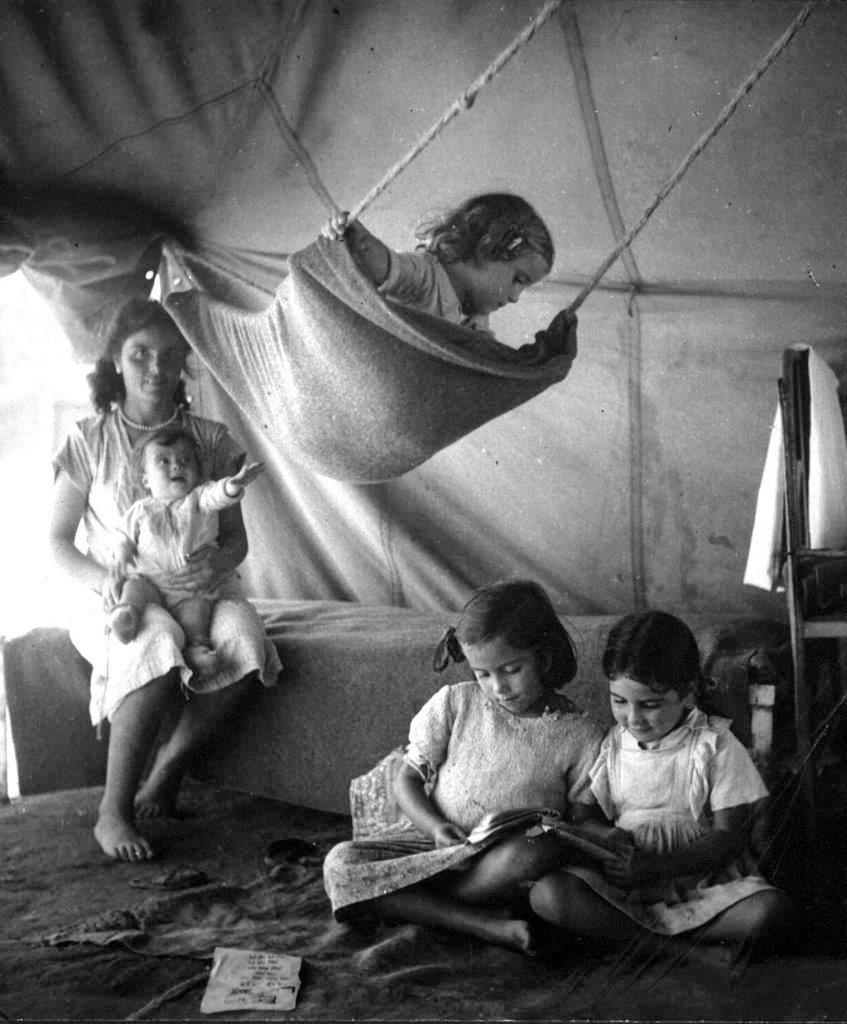
Arab-Isreali-Palestinian Conflict: Refugee Policy

Figure 1.--We see this photograph used on many internet pages, but have not been able to find much informtion about it. The seem to be North African Jews, we are not sure which country. We are not sure when they arrived in Israel, but the photograph was taken in 1950 at a transit camp. Unlike Arab policy which was to keep refugees for decades in squalid camps and not assimilate them, Israeli policy was to get refugees out of the camps and begin the integration proess as soon as possible. Photographer: Zoltan Kluger.
|
|
The First Arab Israel War created huge numbers of regugees. This included not only Arabs and Jews in Palestine itself, but also Jews throughout the Middle East. News about the war inflamed the Arab public. The situation variesd somewhat from country to country. Jews were forced to flee Arab countries where they were attacked, arrested, beaten, and stripped of their policy. Many but not all sought refuge in Israel. Unlike other countries, Israel took in all Jews without question. There was thus a major refugee crisis on both sides. The arabs and Israel, however, had very different policies toward the refugees. The Arabs did not accept the United Nations partition or the establishment of a Palestianian state. Rather the invading armies (Egypt, Jordan, and Syria) annexed the area of Palestine that they seized. Not only did they not create a Plaestinian Arab state, but they refused to integrate the Palestinians in their population. Arab sources report 0.8-1.0 Palestinian refugees. Manfate census data suggest that this is an inflated number, greater than the entire Palestinian Arab poplation. Some 0.2 million Arabs remained in Israel after the War. This means that the number of Palestinian refugees was anout 0.6-0.7 million. These unfortunate people were confined to fetid camps, not by the Israelies, but their fellow Arabs. Arab governments did not allow them to move into the counry proper or seek jobs. Here policies varied from country to country. The Arab countries saw the Palestinin refugees as a disruptive influence and thus wanted them confined to camps. In addition they wanted to keep the distruction of Israel a major issue and the dispair of the Palestinian Arabs in these camps was a useful propganda tool. The number of Jews fleeing Arab countries for Israel in the years following Israel's independence was roughly equal to the number of Arabs that left Israeli occupied areas of Palestine. These Jews were forced to leave with little more than the shirts on their backs. Unlike the Arab refugees, they had had no desire to be repatriated. Little is now heard of them because Israeli policy was radically different than Arab policy. Israeli policy was to get the refugees out of the camps as soon as possible and assimilate them into Israeli society no mather where they came from. As a result, most Jewish refugees spent very little time in refugee camps. There were some 0.8 million Jewish refugees, some 0.6 million were quickly resettled in Israel at considerable expense. There was no offer of compensation from the Arab governments who appropriated their property and possessions. Nor was there any thought of using the funds generated to aid or compensate the refugees.
CIH

Navigate the Children in History Website:
[Return to Main Arab and Jewish Palestinian refugee page]
[Return to Main Arab and Jewish Palestinian page]
[About Us]
[Introduction]
[Biographies]
[Chronology]
[Climatology]
[Clothing]
[Disease and Health]
[Economics]
[Freedom]
[Geography]
[History]
[Human Nature]
[Ideology]
[Law]
[Nationalism]
[Presidents]
[Religion]
[Royalty]
[Science]
[Social Class]
[Bibliographies]
[Contributions]
[FAQs]
[Glossaries]
[Images]
[Links]
[Registration]
[Tools]
[Children in History Home]
Created: 7:42 AM 12/10/2016
Last updated: 7:42 AM 12/10/2016



